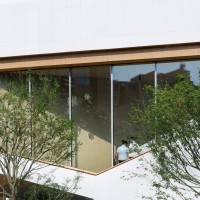Atelier XI . photos: © arch-exist photography, zhang chao
In 2019, the architect received a commission to design a standard 6-classroom kindergarten in Wuhan.
Floating Fairylands
As the architect lived in Wuhan during childhood, he paid a visit to the kindergarten he had attended at the start of the design stage. However, it turned out that the kindergarten in reality was far smaller compared to the image that had resided in his mind for long–the spatial scale was subconsciously exaggerated by childhood memory. Inspired by this experience of deformed scales, the architect proposed to establish a unique spatial perception in which children’s spaces are to be felt enlarged as the surrounding cityscape shrinks. As a result, a floating miniature city for children is created as a cluster of pods scattered around on the ground, in the air, under the sun, and in the shadow.
However, its function as a kindergarten is only half of the design task. The other requirement for this building is to have it serve as a sales pavilion in the first year after its completion. Therefore, additional strategies on programmatic rearrangement and alternating visual images must be deployed to repurpose the sales pavilion for kindergarten use after it finishes its one-year operation.
Usually real estate development projects will build a temporary sales center and demolish it later. However, by adapting one building for two purposes, this project hopes to save the construction cost of a temporary sales center and avoid the environmental consequences caused by the unnecessary demolition.
In a sense, it is a major challenge in this project to create a spatial structure that serves as both a sales pavilion and a kindergarten at different times with completely different themes and regulatory requirements.
Through research, the design team experimented to decompose this single building into a series of adaptable units that can be transformed from one function to another. For instance, such conversion may happen between the 120~140 square-meter model apartments for sales useand the typical 120 square-meter kindergarten classroom. Some exhibition halls can also be adapted into general activity classrooms that demand similar spatial dimensions. Taking these functional requirements into consideration, the architect envisions a parallel between the floating miniature city belonging to children and the series of model galleries that lead visitors to envision their future homes.
The completed building appears as connected “voids”. Series of internal spaces are joined through intricate folds that are visually expressed on the exterior facade and the roof. The single chunk of the building volume is broken into a sequence of voids with discrete qualities being high, low, wide and narrow. They face different directions and bathe in different sunlight and shadow conditions. The architect expects that the playfulness of these rooms with spires, flat roofs or inverted roofs is able to stimulate children’s interests in shapes of spaces and to endow each classroom with distinctive identity by offering unique lighting and landscape views. Children are encouraged to explore, wander, and grow in such interconnected micro cities.
As for the sales pavilion, the architect aims to overturn the conventional model of enclosed, over-decorated interior sales spaces. Instead, a more embracing gesture towards the surrounding urban environment is envisioned with interior spaces honestly presented on the exterior facade, allowing the spatial structure rather than facade decoration to become a unique landmark. The connected interior “void” spaces will form a chronological visiting sequence: the past (urban environment and model display) – the present (show house display)-future (exhibition on health intelligence and eco-garden).
The structure, facade and the interior of the building are highly integrated. The reinforced concrete structure conforms to the logic of the internal spaces, and the facade uses white granite stone and glass curtain walls to express the overall skeleton and the folded interior. When the sales pavilion ends its operation, the outdoor landscape will be renovated as open playground. Simultaneously, small structural adjustment will be conducted to transform sales exhibition spaces with greater height into more compact teaching spaces through inserting additional floor slabs. On the facade, preset measures will also be used to adjust glass curtain walls into operable windows for kindergarten use.
The project is located in Hankou, Wuhan, only 1 kilometer away from the South China Seafood Market where the pandemic first broke out. The project was conceived in October 2019 and was originally planned to be completed and used in 2020, but it was temporarily suspended due to the disease. However, thanks to the unremitting efforts of the whole project team, the project plan was not canceled. After the unblocking of Wuhan, the construction progress was restored. It was eventually completed and opened to the public in August 2021.
Across the pandemic, the theme of the exhibition hall in the building has been adjusted from the Hankou City Memory Hall to the theme of Health Intelligence and Ecological Living. The building is expected to not only serve as sales promotion space, but also as a platform to familiarize local residents with knowledge about health and technology, and to boost confidence of the community by providing insights into a brighter future.
_




























